
reproduction in animals, reproduction of animals, reproduction animals, reproduction in animals and plants, reproduction of animals and plants , sexual reproduction in flowering plants 12 notes, class 12 biology notes, sexual reproduction in flowering plants class 12, sexual reproduction in flowering plants class 12 notes, class 12 sexual reproduction in flowering plants, note biology, biology notes, sexual reproduction in flowering plants, class 12 cbiology chapter 2 notes, 12th standard biology notes, 12th std biology notes, class 12 biology notes chapter 2, sexual reproduction in flowering plants chapter class 12 notes

♦ Site of sexual Reproduction
♦ Male and female reproductive organs are bome on flower
•Four whorls – calyx (sepals), corolla (petals), androecium (Male
reproductive organ), gynoecium (Female reproductive organs)
•Function of calyx:protects the bud.
•Function of corolla :attracts insects by its colour
♦ Androecium consists of Stamens.
♦ Stamen consists of Stamens.
♦ Ather bilobed 4 Microsporangle.
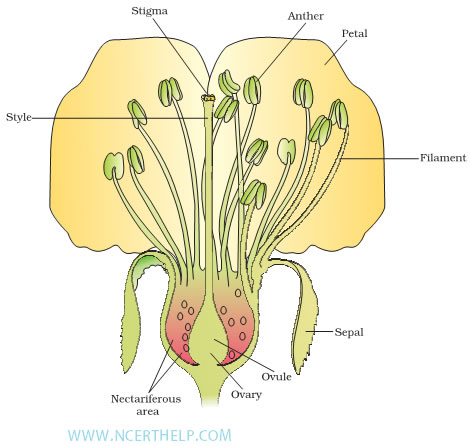
Refer fig. 2.1 of NCERT (L.S. OF A FLOWER WITH DIFFERENT PARTS)
MICROSPOROGENESIS |
||
| The process of formation of micro spores from pollen mother cell through
meiosis is called microsprogenesis. Tapetum :Inner most layer of wall of microsporangium .Cells have dense cytoplasm. Generally have more than one nucleus .Nourishes the developing pollen grain |
||
↓ Microspore (n) ↓ Pollen grains (n) |
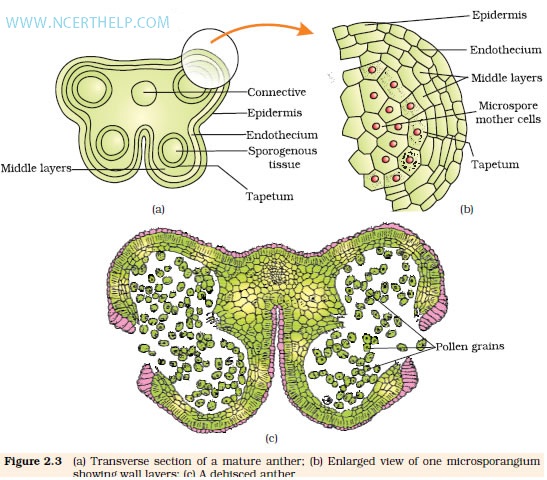
have two outer walls;
i) Exine
ii) Intine
♦ Exine is mase of spropollenin..(Hardest natural substance). Intine is made of cellulose
and pectin.
♦ Mture llen grains have two cells – large vegetative cell & small generative cell.
♦
Generative cell froms to male gameetes by mitotic division.
♦ Pollen grains (Refer fig 2.7 of text book)shed in 2-celled /
3 celled stage)
See Fig 2.5 a and b page 23
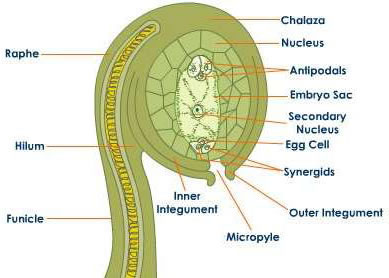
Gynoecium / carpel (the female reproduuctive organ)
(Structure of anatropous ovule)Megasporangium
♦ Each Carpel consists of ovary ,style & stigma.
♦ Ovules are attached to ovary by plaxenta.
♦ Funicle – stalk of ovule .
♦ Hilum, a region where funicie is attached.
♦ Micropyle
a pore for entry of pollen tube & to imbibe
water.
Anatropous ovule
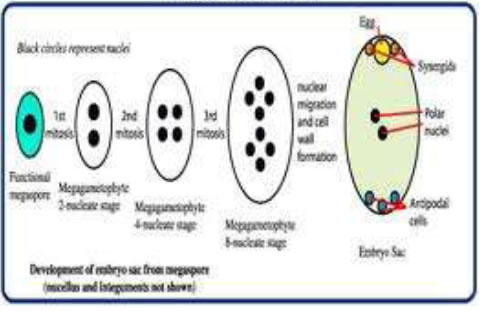
Megasporogenesis |
||||
Megaspore mother cell (2n) Meiosis |
||||
↓ |
||||
4 Megaspores (n) (3 megaspores degenerate, 1 remains functional) |
||||
↓ |
||||
Funtional Megaspore (n) (Divides 3times by mitosis) |
||||
↓ |
||||
8 Nucleated Embryo Sac formed |
||||
↓ |
↓ |
↓ |
||
| 2 polar nuclei at center(n each ) | 3 cells at chalazal end called antipodals(n) | 3 cells group at micropylar end -the egg cell(n) & 2 synergids(n) | ||
POLLINATION– transfer of pollen from anther to stigma. Agents of pollination –air, water, insect.bat,bird,man
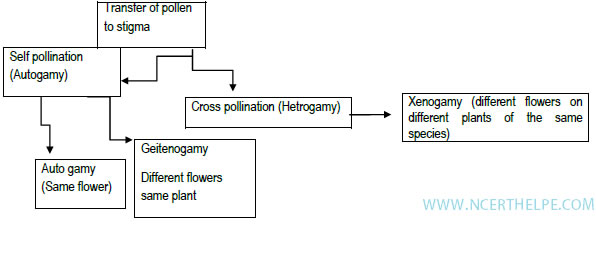
♦ Pollen grains geminate on stigma & pollen tube grows through style.
♦ Pllen tube reaches micropyle
& releases two male gametes into embryo-sac Fertilisation is the process of fusion of male& female gametes (n+n) to form a diploid (2n) zygote.
Syngamy :Fusion of one male gamete(n) with egg (n)![]() Zygote(2n)Produced
First Fusion
Zygote(2n)Produced
First Fusion ![]() Fusion of two Polar Nuclei(n+n=2n)
Fusion of two Polar Nuclei(n+n=2n) ![]() Second fusion
Second fusion ![]() Male Gamete(n) Fuses with the fusion product of the two polar nuclei(3n)
Third Fusion
Male Gamete(n) Fuses with the fusion product of the two polar nuclei(3n)
Third Fusion ![]() fusion of male gamete with egg cell.
fusion of male gamete with egg cell.
♦ Double fertilzation
i)Fusion of male gamete with egg – First fertilization ,SYNGAMY
ii)Fusion of fusion product of polar nuclei with male gamete – Second fertilization .TRIPLE FUSION
Refer fig 2.13 in NCERT
Post fertilisation changes:
Stages of embryo development after fertilization:
1. Zygote divides by mitosis into suspensor & embryo cells
2. Suspensor cell forms a globular basal cell which remains
embedded in the endosperm & a
multicellular suspensor bearing the embryo
3.Globular embryo becomes heart-shaped & then mature
embryo with radicle, plumule &Cotyledons
♦ Primary endosperm nucleus – divides repeatedly to form
endosperm, food for the embryo.
♦ Mature ovary becomes fruit.
♦
Mature ovule becomes seed.
♦
True Fruit develops only from the ovary, e.g. mango, tomato
False Fruit develops from parts of the flower other than the
ovary e.g. apple, peach etc.
i) Albuminous (with Endosperm)
ii) Non albuminous(without Endosperm)
I) Apomixis- Production of seeds without fertilisation e.g.species of Astereceae and grasses.
ii) Polyembryony- Occurrence of more than one embryo in a
seed e.g.Orange.
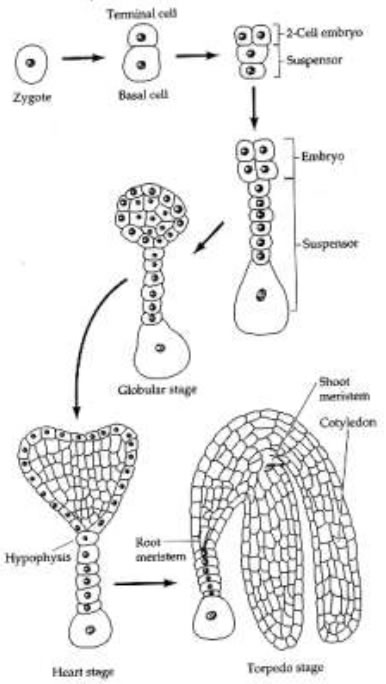
Continued self-pollination result in breeding depression. Flowering plants have developed many
devices to discourage self-pollination & encourage cross-pollination such as
Bearing unisexual flowers Unisexuality Anther & stigma mature at different times Dichogamy Anther & stigma placed at different positions Heterostyly Pollen grains of a flower do not erminate on the stigma of the
same flower Self incompatibility Artificial Hybridisation Heterostyly
Types of cross-pollination performed by man for crop improvement. Achieved by
i) Emasculation i.e. removal of anthers from the flower bud of a bisexual flower before the anther
dehisces using a pair of forceps and
ii) Bagging i.e. covering the emasculated flowers with a bag of suitable size to protect them from
contamination with unwanted pollen

If flower is unisexual, emasculation is not needed. Flower bud bagged & when the stigma becomes
receptive, pollination is done using desired pollen & the flower is rebagged
Pollen –pistil InteractionPollen –pistil Interaction
i) All the events from pollen deposition on the stigma until the entry of the pollen
tube into the ovule are together called pollen-pistil interaction.
ii) It is a dynamic process involving pollen recognition by stigma/pistil for
compatible pollen by accepting them and if incompatible rejecting them.
Copyright @ ncerthelp.com A free educational website for CBSE, ICSE and UP board.